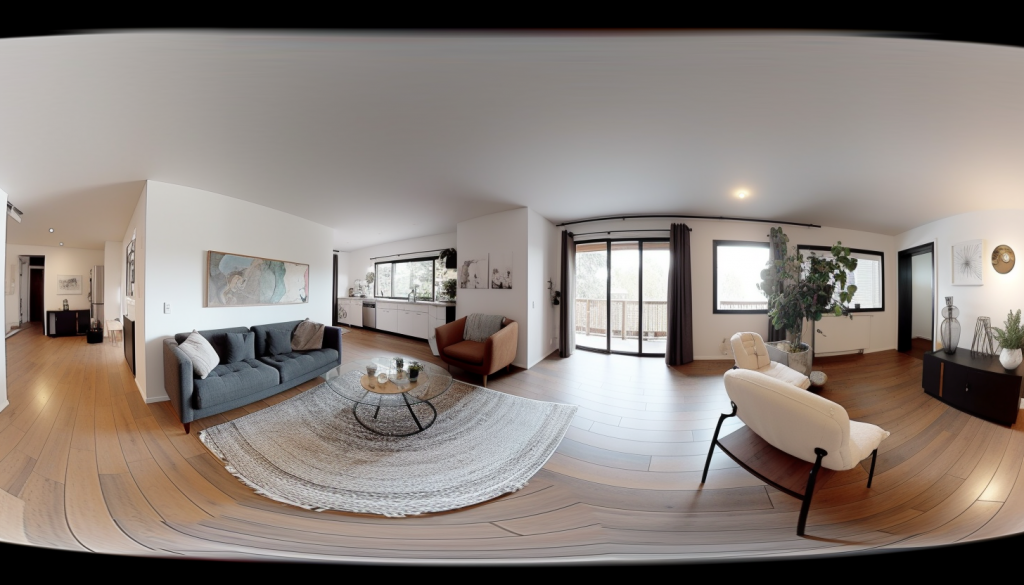Dubai is a city in constant transformation. As each new high-rise reshapes the skyline or another villa takes form along the waterfront, the real estate industry finds new ways to connect people with property.
Among the leading tools affecting such a change is the 360-degree virtual tour, a fully interactive digital experience that simulates the physical process of walking through walls of a space. A series of panoramic, high-resolution images linked together in a navigable format allow such virtual tours to be made, where a viewer could leisurely make their way through each room and view interiors of his/her preference and, easily, get an idea about the layout, scale, and ambiance of the property, without ever setting foot on-site.
In a market as fast-paced and global as Dubai’s, they are quickly being recognized as more than a convenience: they are a necessity.
How 360° Virtual Tours Work
At their core, these tours capture dozens of stills, or video frames, using professional 360° cameras capable of ultra-wide fields of view. Specialized software then stitches each image into a continuous sphere, hiding tripods and correcting lens distortions.
Viewers click or swipe to pan in any direction, replicating the freedom of an in-person stroll. Advanced solutions layer in:
- Spatial mapping and floor-plan overlays that orient viewers to each room’s footprint
- Clickable hotspots revealing fixture details, room dimensions, or material finishes
- Virtual staging that swaps furniture, artwork, or lighting schemes in real time
- Adaptive resolution, ensuring smooth playback on desktop, tablet, and mobile
The technical backbone, premium optics, automated stitching algorithms, and content delivery networks ensure loading is swift and visuals remain crisp, even on slower connections.
Key Benefits of 360 Virtual Tours for Real Estate
Deeper Emotional Engagement
Prospects linger longer when they can examine marble veining, trace crown-molding profiles, or peer out over cityscapes. This immersive quality sparks sincere interest and richer inquiries.
- Global Accessibility: Share a single URL via email, social media, or property portals and grant 24/7 “open house” access to overseas investors. No long-haul trips required.
- Efficient Lead Qualification: Virtual tours act as a robust pre-screening tool. Only buyers who truly connect with a layout or finish schedule during in-person visits reduce no-shows and accelerate negotiations.
- Distinct Competitive Edge: In a crowded luxury market, a polished 360° walkthrough signals professionalism, innovation, and attention to detail, qualities that static photos alone can’t convey.
- Data-Driven Insights: Heat-map analytics show most-viewed angles, click-through hotspots, and drop-off points. Armed with this data, agents refine staging choices and tailor follow-up conversations.
- Cost-Effectiveness Over Time: While initial production carries an investment, virtual tours reduce repeated in-person showings, travel expenses, and staging costs, delivering measurable ROI across multiple listings.
Why Dubai’s Market Is Ideal
Dubai isn’t just a collection of buildings; it’s a global crossroads. International buyers, from Europe, Asia, or beyond, often decide before landing in the Emirates. The city’s sophisticated tech infrastructure, high smartphone adoption, and appetite for digital conveniences all feed into a demand for immersive property previews.
Moreover, Dubai’s ethos of pushing boundaries, through record-smashing skyscrapers, smart-city initiatives, and sustainable communities, makes 360° tours a natural addition to real estate marketing arsenals. Agents adopting them not only meet buyer expectations but also reinforce Dubai’s reputation as a hub of innovation.
Technical Considerations and Best Practices
- Invest in Quality Capture: Use professional 360° rigs or LiDAR-equipped devices to avoid distortion and ensure even lighting.
- Pre-Plan Your Route: Map a logical sequence: entrance → living spaces → bedrooms → outdoor terraces. A coherent flow keeps viewers oriented.
- Mind Your Lighting: Shoot during soft daylight hours, and deploy balanced artificial lights to eliminate harsh shadows or overexposed windows.
- Optimize for Web Delivery: Compress panoramas intelligently. Fast load times discourage clicks-away, while progressive loading sustains engagement.
- Add Contextual Layers: Embed brief captions, highlight architectural flourishes, or integrate narrated audio guides to transform a tour into a compelling story.
- Ensure Mobile Responsiveness: Verify that swipe-based navigation and adaptive layouts work flawlessly on smartphones and tablets, where many overseas buyers will view tours.
Conclusion
As Dubai’s real estate competition intensifies, agents and developers must adopt strategies that resonate with a globally dispersed clientele. A 360° virtual tour does more than display brick and mortar; it transports viewers into a property’s heart, forging connections that static images cannot.
By deepening engagement, widening reach, streamlining lead qualification, providing actionable insights, and reducing costs, these tours accelerate sales lifecycles and bolster market positioning.
An essential accompaniment for the professional looking to harness this digital frontier will be providing an acquaintance with a reputable supplier.
Limina Studios, based in Dubai, crafts bespoke 360° experiences, from basic panoramas placed on a webpage to completely interactive 3D environments. Our dual expertise in technical execution and local market dynamics ensures every property shines in its best light. As buyer expectations evolve and technology advances, integrating top-tier virtual tours shifts from a marketing novelty to an indispensable ingredient for real estate success.






















